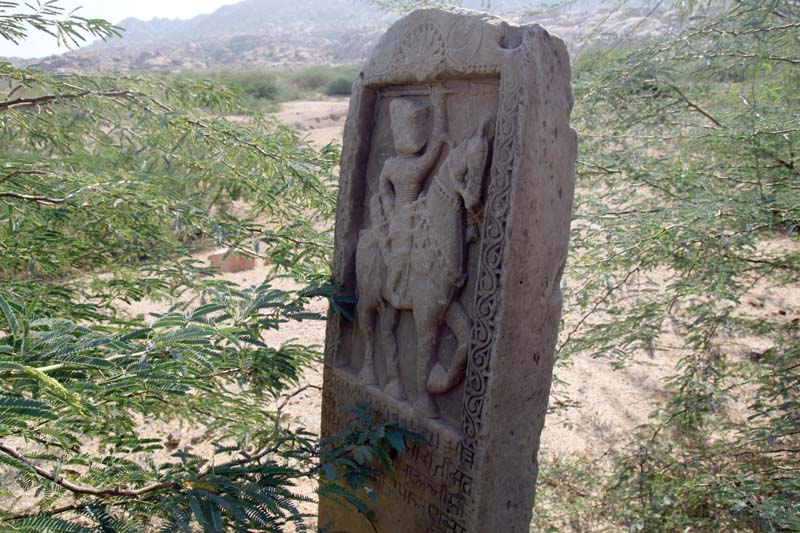
Two crumbling stones, a little over three feet tall, strewn in the lap of Karonjhar Mountain, show a woman, her arms covered with bangles, holding a man's body in her arms. This is where the women must have stood before they set themselves alight under the custom of Sati.

"Sati” or “Suttee” was a practice once common in the subcontinent. In this, women, especially those belonging to the royal family, were made to commit suicide by self-immolation after a husband's death. While their husband's body was cremated, they were reduced to ashes on the side.
Residents say such stones are found in various areas of Tharparkar district and Hindus consider them as sacred sites. “There were a few other stones here, which either have been taken away by someone or have just eroded with time,” said Kesu Lal Menghwar, who teaches at the primary school in Bhodhesar village, barely two kilometres away from the site.
“These graves go unnoticed. The stones are covered with bushes and trees and are barely visible. Government officials never bother to come here either or make any effort to preserve these stones,” he said.
Qasim Ali Qasim, director of the archeology department, said the government had not paid attention to these memorials because they do not fall under the list of protected sites.
According to Hindu mythology, the wife of Lord Shiva had committed suicide because her father had insulted her husband. She has thrown herself into the 'sacrificial fire' and this is where the custom comes from. But historians, quoting the old tradition in Hinduism, said it was considered the wife's duty to keep her husband alive, therefore, people used to consider it the woman”s fault if her husband died.
“After the death of a man, people would believe that he is not dead until his wife goes with him to heaven. The widows would put themselves on fire along with their dead spouses and this practice continued for centuries,” said writer Noor Muhammad Jhinghi.
The memorials of these women are said to be in Mithi, Nagharparkar, Islamkot, Chachro as well as on the other side of the border in India.
Anthropologist Zulfiqar Ali Kalhoro, who recently conducted a research on the stones of Satis in Tharparkar district, said there were nearly 25 different types of stones in the area. “The memorial stone of Satimata (the mother of Satis) is also found here. A woman named Kaso Mai had set herself on fire with her son Harnath Rajput, who was defeated in battle,” he said. The story goes that Harnath's wife, who belonged to the Sodha Rajput family, refused to burn herself which is why his mother performed the ritual and became known as Satimata.
Another historical memorial stone is of Jhoma Sati, who belonged to the Chharan community. Kalhoro said people still visit the memorial stone of Jhoma whose shrine is located in Chachro taluka of Tharparkar district. “There is a different story about her. She reportedly burned herself alive to stop the atrocities of the Baloch, who used to plunder her area. She is worshipped by the Meghwar and Bheel community,” he said, adding many of these people have now migrated to Rajasthan and Gujarat. Annual festivals to remember Jhoma are still held in India.
“People believe that she had rendered sacrifices for a cause so they have given her the status of a goddess and have a constructed a shrine in her memory,” Kalhoro said.
It is unclear what language has been inscribed on the stones. Some say it is Sanskrit, while others claim it is Gujarati.
Professor Dr Ghulam Muhammad Lakho, a history professor at the University of Sindh, said it was Devanagari and Parkari languages that were once common in this area. According to Professor Lakho, it was originally a tradition followed by Rajput women that was adapted by other communities later. “Initially when the prohibition was placed on the custom, some lawmakers belonging to the Rajput community opposed it. The government finally banned it in 1835, calling it an inhuman practice. The ban was implemented in letter and spirit by the British government after 1843,” he said. Despite the ban, a case was reported from India in the 1980s, but we have not heard about the practice since then, Lakho added.
Published in The Express Tribune, March 6th, 2015.























COMMENTS
Comments are moderated and generally will be posted if they are on-topic and not abusive.
For more information, please see our Comments FAQ